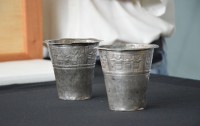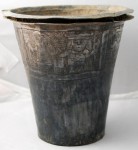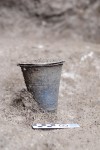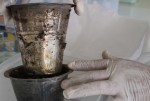 High in the Andean cloud forest of Peru’s remote Amazonas Region, archaeologists excavating the site of Purunllacta de Soloco have unearthed two silver vessels that lend unique insight into the history of the area in the transitional period after the Spanish conquest. Built by the pre-Inca Chachapoya culture, Purunllacta de Soloco is a thousand-year-old fortress with forbidding stone walls perched on a mountain top covered in jungle vegetation. The site, while known, was excavated by archaeologists for the first time in 2014, and no wonder, since it takes three hours of hard climbing from the town of Chachapoyas to reach the summit.
High in the Andean cloud forest of Peru’s remote Amazonas Region, archaeologists excavating the site of Purunllacta de Soloco have unearthed two silver vessels that lend unique insight into the history of the area in the transitional period after the Spanish conquest. Built by the pre-Inca Chachapoya culture, Purunllacta de Soloco is a thousand-year-old fortress with forbidding stone walls perched on a mountain top covered in jungle vegetation. The site, while known, was excavated by archaeologists for the first time in 2014, and no wonder, since it takes three hours of hard climbing from the town of Chachapoyas to reach the summit.
The cups are ceremonial vessels known as aquillas, used by the Inca in almost every ritual and found all over their former empire. They are 4.4 inches high and 4.6 inches in diameter at the widest point around the rim. They each weigh 152 grams (5.36 ounces) and are made from sheets of relatively thick (.8 – 1mm) silver. They taper to a wide mouth with a straight lip around the rim. They are in excellent condition, with no visible signs of corrosion or any corrosive by-products like carbonates, chlorides and copper oxides. The lack of silver chlorides indicates the percentage of pure silver is very high.
 The slightly concave walls are decorated under the rim with a high relief of figures divided into four scenes separated by two parallel vertical lines. Horizontal parallel lines frame the relief top and bottom. Each of the scenes features two characters, male and female, wearing clothes with geometric patterns and hats or headdresses. The characters hold hands, facing outwards. Some of them carry a bag or an axe. There are also points and notches in low relief in the background. The hats are typical of Spanish colonial style and the geometric garments are the traditional dress of the Inca empire.
The slightly concave walls are decorated under the rim with a high relief of figures divided into four scenes separated by two parallel vertical lines. Horizontal parallel lines frame the relief top and bottom. Each of the scenes features two characters, male and female, wearing clothes with geometric patterns and hats or headdresses. The characters hold hands, facing outwards. Some of them carry a bag or an axe. There are also points and notches in low relief in the background. The hats are typical of Spanish colonial style and the geometric garments are the traditional dress of the Inca empire.
The decoration was made using a mixture of three techniques: repoussé, embossing and incision. The repoussé was done by wrapping a single sheet of metal around a wooden mold on which the decoration had been carved and hammering the sheet against the molds until the relief transferred. Embossing was done by drawing concave shapes into both sides of the metal with a blunt tool. The incised designs were carved into the outside of the metal sheet. The quality of the relief work is exceptional.
Because of the Spanish influence, archaeologists believe these vessels were carved during the first Spanish occupation of the area between 1536 and 1580. This is the first time silver aquillas have been found at Chachapoya sites. They were not known to have worked in precious of semi-precious metals so it’s probable the vessels were of Inca manufacture rather than made locally. Wood artifacts carved with Inca-style figures dating to 30 years after the Spanish conquest have been recovered from Chachapoya sites before, however, and it’s not entirely impossible that the aquillas were made by Chachapoya artisans influenced by the Inca and Spanish, but the strength of the relief indicates very expert silversmithing that was not native to Chachapoya culture.
 The aquillas were found nested into each other inside a hole and were probably ceremonial offerings. A stone building was then constructed above the vessels. The fact that they were made and deposited up to 50 years after the Spanish arrived means that the Andean elites were still practicing traditional rituals for decades after the conquest. It also confirms that both the Inca Empire, which conquered the Chachapoya in the 15th century (a fitful conquest, since the Chachapoya resisted their invaders so consistently for so long that they actually sided with the Spanish when they first arrived), and the Spanish in the 16th century reached the remote, strongly fortified settlement of Purunllacta de Soloco, something archaeologists have believed but found no archaeological evidence of until now.
The aquillas were found nested into each other inside a hole and were probably ceremonial offerings. A stone building was then constructed above the vessels. The fact that they were made and deposited up to 50 years after the Spanish arrived means that the Andean elites were still practicing traditional rituals for decades after the conquest. It also confirms that both the Inca Empire, which conquered the Chachapoya in the 15th century (a fitful conquest, since the Chachapoya resisted their invaders so consistently for so long that they actually sided with the Spanish when they first arrived), and the Spanish in the 16th century reached the remote, strongly fortified settlement of Purunllacta de Soloco, something archaeologists have believed but found no archaeological evidence of until now.
 After they were excavated, the aquillas were sent to the Brüning National Archaeological Museum in Lambayeque for cleaning and conservation. Some kind of organic residue has been found inside the vessels. Researchers will test the substance to identify its makeup. Since the vessels were likely used for ritual purposes before their deliberate burial, whatever they held will tell us more about the ceremony. (The Incas used chicha, fermented corn beer, in their rituals.)
After they were excavated, the aquillas were sent to the Brüning National Archaeological Museum in Lambayeque for cleaning and conservation. Some kind of organic residue has been found inside the vessels. Researchers will test the substance to identify its makeup. Since the vessels were likely used for ritual purposes before their deliberate burial, whatever they held will tell us more about the ceremony. (The Incas used chicha, fermented corn beer, in their rituals.)
Conservation took three months and is now complete. The aquillas have been officially transferred to the Regional Directorate of Culture of Amazonas who will keep them until they go on display in the new Regional Museum of Chachapoyas which isn’t open yet. The space will need to be modified to display the vessels in ideal climactic conditions and keep them secure.
Fantastic, an intriguing find! Thank you for sharing this.
I can’t believe how good they look!